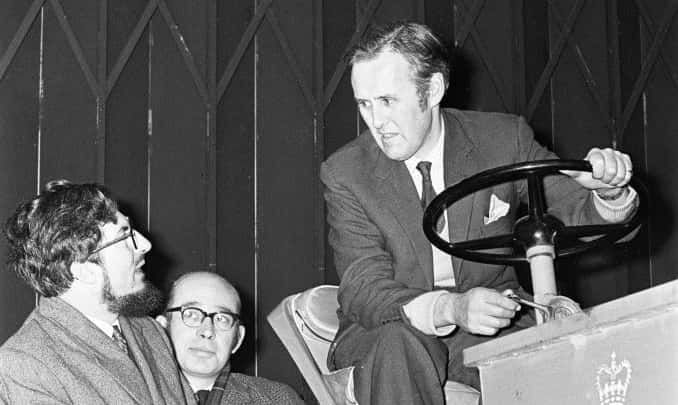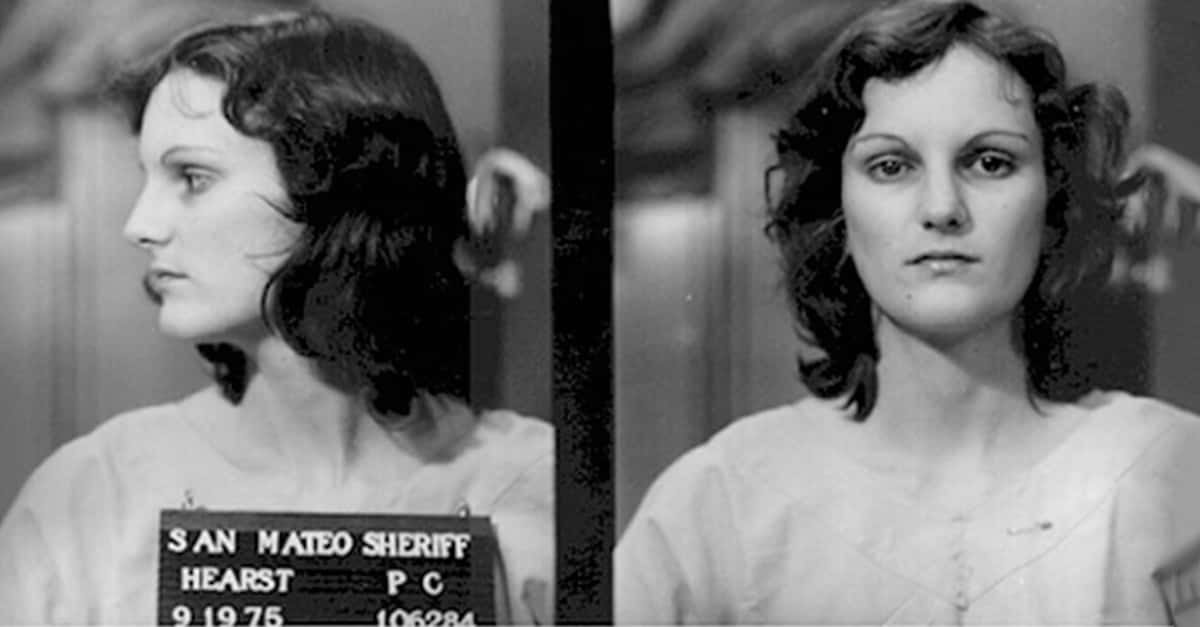"There's always some days you wish things had never happened, like you'd never been born, that sort of thing but I'm not the kind of person anyway that can just sit around and say, "gee, I wish that never happened". I don't ever do that. There's no point. That is a total and complete waste of time".—Patty Hearst
The legend of Patty Hearst has faded somewhat with the passing of time, but there was a time when her life astonished and fascinated millions of people all over the world. The granddaughter of one of the richest men in the US, famously the victim of a kidnapping by a revolutionary cell, only to be put on trial for taking part in offenses alongside the very people who kidnapped her! However, things became complicated even further when the subject of brainwashing was brought up. A lot of questions were raised, and the different accounts have made it difficult to figure out what really happened. Hopefully these 24 facts can help clarify this complicated case, but still, there are some things that the public will simply never know about this famous case.
1. A Revolution That Never Came
Patty Hearst was kidnapped by a group that called themselves the Symbionese Liberation Army, an anti-racist and anti-capitalist left-leaning group which saw themselves as the forerunners of a revolution in the making. While they didn’t initially start off as radical as they did, the group eventually moved towards violent offenses like bank robberies and even murder in their attempts to further their ultimate goals.

2. The Film Rights
Three movies have been made about Hearst’s life during her time with Symbionese Libertarian Army: Patty Hearst, Guerilla: The Taking of Patty Hearst, and The Radical Story of Patty Hearst. Unfortunately, there was never a chance to make the sequel we all wanted: Patty Hearst 2: Electric Boogaloo.
3. Rosebud…
Hearst’s grandfather was William Randolph Hearst, the creator of the largest newspaper empire in the entire world. Eventually, Hearst expanded his operation to magazines, newsreels, and even movies. He wielded immense influence over the United States political system (and entertainment system) for decades, and the Hearst family was known for its staunchly anti-communist activities after World War II. William Randolph Hearst was such a towering (and controversial) figure that Orson Welles actually made a movie to criticize his life and activities: Citizen Kane.
4. Living The Carefree Life
Patty Hearst was one of William's son Randolph Apperson Hearst's five daughters. Because of her other siblings, and because Randolph was himself just one of his father’s five children, Patty was one of many heirs to her grandfather’s vast wealth. In fact, it wasn’t even considered necessary to provide Patty with any kind of security at all, despite her famous name.
5. Back When Things Were Simple
At the time when Hearst was kidnapped, she was studying art history at the University of California, Berkeley. Not only that, she no longer resided on her family's glamorous estates, and was instead living in an apartment with her fiancé, Steven Weed.
 Getty Images
Getty Images
6. A Bonnie Without A Clyde
Months after she was initially kidnapped, on the 15th of April 1974, surveillance video recording a bank theft in San Francisco was determined to have captured footage of Hearst holding a firearm and taking part in the heist. While it was widely noted that she may have been acting under duress, US Attorney General William B. Saxbe declared Hearst to be a “common criminal” and she was indicted by a grand jury for robbery in June 1974.
7. Making Good
Years after her ordeal, Hearst moved to the East Coast and became a philanthropist. She was particularly devoted to a foundation aimed to help children suffering from AIDS.
8. You’re A Star
Years after the scandal, during the 1990s, Hearst built up an acting career for herself, specifically in films helmed by controversial B-movie director John Waters. Hearst appeared in five of his films, including Serial Mom where she appears as a juror (no doubt it was nice for her to be on the other side of a courtroom after what she’d gone through).
 Serial Mom, 1994, Savoy Pictures
Serial Mom, 1994, Savoy Pictures
9. Such A Charming Lady
In May 1974, Hearst and other members of the SLA were fleeing a shootout with authorities. They jumped into two cars and took their owners captive. Allegedly, one of the drivers was a young man who was so drawn to Hearst that he was actually reluctant to file charges against her! What goes around, comes around, sometimes…

History's most fascinating stories and darkest secrets, delivered to your inbox daily.
10. This Act Has A Motive
Hearst was kidnapped by the SLA in response to two of its members being apprehended by the authorities. Joseph Remiro and Russell Little had been detained for the murder of school superintendent Marcus Foster in Oakland, and the rest of the SLA decided to take a wealthy captive to secure their release. However, another reason that Hearst was kidnapped was because she happened to live close to the SLA headquarters. A wrong place, wrong time situation.
11. We’re Gonna Scrooge You!
When it came out that the vast influence of the Hearst family still wouldn’t get their imprisoned comrades out of lockup, the SLA instead demanded that the Hearst family give $70 worth of food to every Californian who was living in some level of poverty. Adding all those people together, this meant spending $400 million dollars. Hearst’s father instead took a loan and donated $2 million to the Bay Area’s poor. However, the operation was mishandled, and the SLA still refused to hand over Hearst.
12. Doesn’t That Count As Conflict Of Interest?
Because of her involvement in several robberies and use of an unlawful firearm, Hearst was apprehended and put on trial, where she sought to convince the judge and jury that she had been brainwashed into joining the SLA. Judge Oliver Carter, however, determined that she had voluntarily joined the SLA, based on statements she’d released on tape and in writing while she was with them. It didn’t help that Judge Carter was professionally linked to a member of the prosecution team. Somehow, we feel like maybe he should have recused himself from that situation…
13. Shaved Off 28 Years At Least…
Hearst was convicted on the 20th of March 1976, with Judge Carter giving her the maximum sentence of 35 years in prison, pending a reduction at the final sentencing. However, Judge Carter passed on before he could specify the number of years she’d serve, so it fell to Judge William Horsley Orrick Jr., who sentenced her to seven years.
14. Too Sinister To Be Light-Hearted About It
According to Hearst’s testimony, members of the SLA—specifically William Wolfe and Donald DeFreeze—sexually assaulted her after SLA founding member Angela Atwood declared to Hearst that the members of the group wanted to make her understand what sexual freedom was really like. Safe to say that doesn’t sound like “sexual freedom"—in fact it sounds like the exact opposite.
15. Patty’s Best Friend
In more recent years, Hearst has returned to the public eye with the help of her dogs. She and her dogs have participated in dog shows at Madison Square Garden at least twice. Her Shih Tzu and French Bulldog won prizes in 2015 and 2017, respectively.
16. Keepsake Or Keeping An Artifact Safe?
One bit of evidence used against Hearst during her trial was the fact that she’d been given a trinket by William Wolfe, one of the men who had allegedly assaulted her. The prosecution used this trinket as proof that Hearst had had a consensual relationship with Wolfe, while Hearst had protested that she’d only kept it because it was a stone carving which she had thought was of archeological significance. The jurors were unconvinced by Hearst’s view on the matter.
 Getty Images
Getty Images
17. Nick-Namesake
In an audiotape released to the public on the 3rd of April 1974, Hearst confessed that she had joined the SLA. She took on the name "Tania," which she had taken from Haydée Tamara Bunke Bider (also known as Tania the Guerilla), who had been a loyal comrade to renowned revolutionary Che Guevara.
 Wikipedia
Wikipedia
18. True Love Found At Last
While she was on bail, awaiting her trial, Hearst was protected by a private security detail, one of whom was policeman Bernard Lee Shaw. Shaw and Hearst fell in love, marrying two months after Hearst was released from prison in 1979. The marriage lasted until Shaw’s passing in 2013.
19. Build-A-Bomb
Allegedly, Hearst was involved in constructing home-made explosive devices during her time with the SLA. In the summer of 1975, these devices were used in attempts on two policemen’s lives, but the attempts were both unsuccessful.
20. Get That Doctor’s Note
While she was in prison, Hearst suffered a collapsed lung, requiring emergency treatment. This medical situation prevented her from testifying against members of the SLA on no less than eleven charges, for which she was also arraigned.
21. Pardoning Patty
President Jimmy Carter commuted her sentence 22 months after she began serving her time. In 2001, Hearst received a full pardon for her offenses by President Bill Clinton.
22. Making The Most Of An Arrest
Hearst was apprehended by authorities on the 18th of September 1976 while she was staying in an apartment on the run with a member of the SLA. Reportedly, she used “Urban Guerilla” as her listed occupation and urged her attorney to tell everyone that she was “smiling,” felt “free and strong,” and that she sent her “greetings and love to all the brothers and sisters out there". At least at this point, she didn't really sound like someone who was acting under duress.
23. Kidnapping Is Bad, Who Knew?
When Hearst was examined by doctors after her arrest, they discovered that she only weighed 87 pounds, suffered from nightmares, her IQ was recorded as being lower than it had been the last time she’d been tested, she used nicotine excessively, and exhibited signs of memory loss regarding her life before encountering the SLA. One doctor even described her as being a “low-IQ, low-affect zombie". Ouch…
24. Where’s Liam Neeson When I Need Him?!
According to Hearst’s testimony at her trial, she had been kept in a closet, blindfolded and tied to a chair, for a week. She received constant threats against her life from SLA member Donald DeFreeze before she was permitted (still blindfolded) to engage in any kind of conversation whatsoever.






























